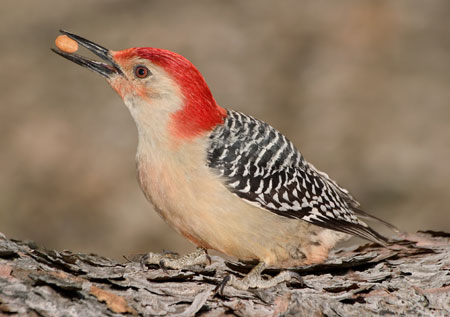Melanerpes carolinus
Is it a Red-headed Woodpecker? No. That species has a deep crimson color covering the entire head from the base of the bill to the shoulders. Then, where is the red belly? Well, there is a faint reddish hue that is difficult to see! The best field mark for identifying the Red-bellied Woodpecker is its zebra-patterned back. The only other species with this black and white back pattern are found in the southwestern United States. So if you live east of the Mississippi and spot a medium-sized (9-10″ length) woodpecker with a zebra-like back and red on the head, you have a Red-bellied Woodpecker at your feeder! The red head pattern will make it easy for you to tell the sex of your visitor: males have red continuously from the base of the bill to the nape of the neck. Females have red only at the bill base, and then again on the nape.
In recent years the range of the Red-bellied Woodpecker has been expanding northward due to maturing woodlands and thanks to the popularity of backyard birdfeeding. Today, they can be found throughout eastern half of the country. While found in a variety of habitats, their preferred nesting territories contain mature, large diameter hardwood trees.
Red-bellied Woodpeckers like to eat! A partial list of foods includes: acorns, pecans, beechnuts, hazelnuts, corn, tree sap, lizards, caterpillars, insects, fruits, berries, and seeds! They will visit hummingbird feeders for nectar. They will consume oranges put out for orioles. A seed mixture rich in sunflowers, nuts, and corn (read: Aspen Song® Nut & Fruit Woodpecker Mix!) will become a favorite feeding site for this opportunistic species. Red-bellies have no problem in extracting the nutritious nutmeats from seeds and nuts with tough shells. They often will wedge the seeds in crevices of trees and hammer the shell open with their bill to access the food inside. Studies suggest their diets are 70% vegetable matter and 30% animal. Red-bellied Woodpeckers also store food in caches they establish and remember within their territory.
Red-bellied Woodpeckers like to eat! A partial list of foods includes: acorns, pecans, beechnuts, hazelnuts, corn, tree sap, lizards, caterpillars, insects, fruits, berries, and seeds! They will visit hummingbird feeders for nectar. They will consume oranges put out for orioles. A seed mixture rich in sunflowers, nuts, and corn (read: Aspen Song® Nut & Fruit Woodpecker Mix!) will become a favorite feeding site for this opportunistic species. Red-bellies have no problem in extracting the nutritious nutmeats from seeds and nuts with tough shells. They often will wedge the seeds in crevices of trees and hammer the shell open with their bill to access the food inside. Studies suggest their diets are 70% vegetable matter and 30% animal. Red-bellied Woodpeckers also store food in caches they establish and remember within their territory.
This woodpecker is a very vocal species frequently drumming and calling its “kweerr” or “churr” sounds in your backyard. These vocalizations are used as communications between members of the family as well as to establish and define territories.
As primary cavity nesters, Red-bellied Woodpeckers excavate a new cavity each year. They generally select dead trees (snags) or dead limbs in live trees. There are cases where they have also used fence posts and utility poles. Red-bellies frequently use the same tree in successive years, building a new cavity each season. Trees have been found with 3-4 cavities lined down the trunk!
Reference
Shackelford, Clifford E., Raymond E. Brown and Richard N. Conner. 2000. Red-bellied Woodpecker (Melanerpes carolinus), The Birds of North America Online (A. Poole, Ed.). Ithaca: Cornell Lab of Ornithology.

